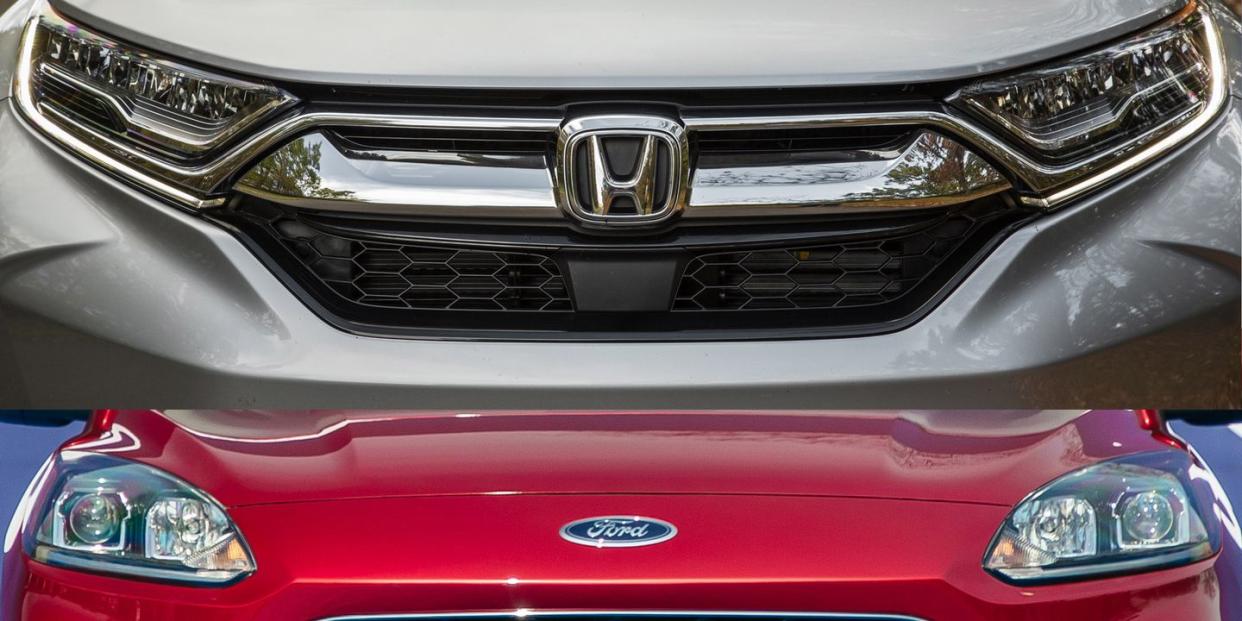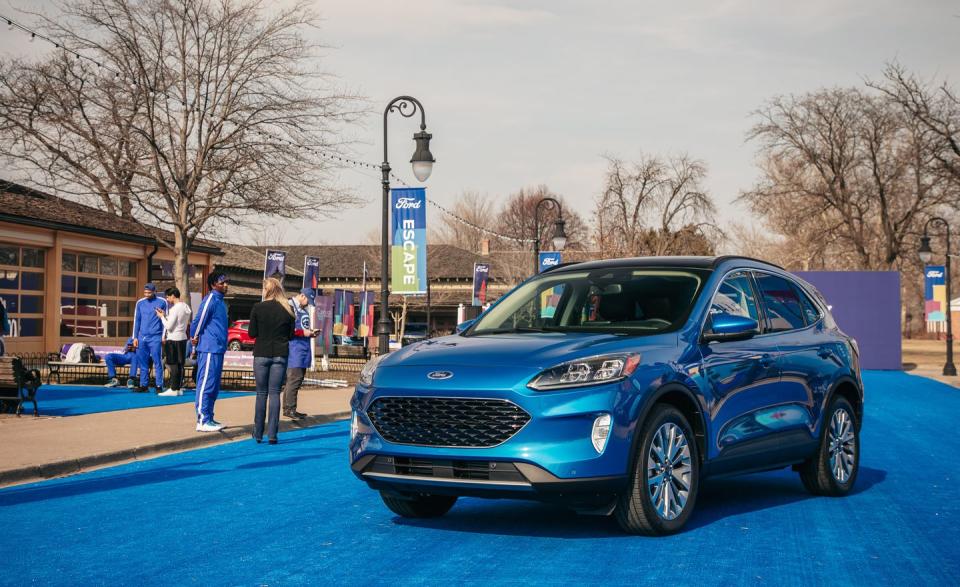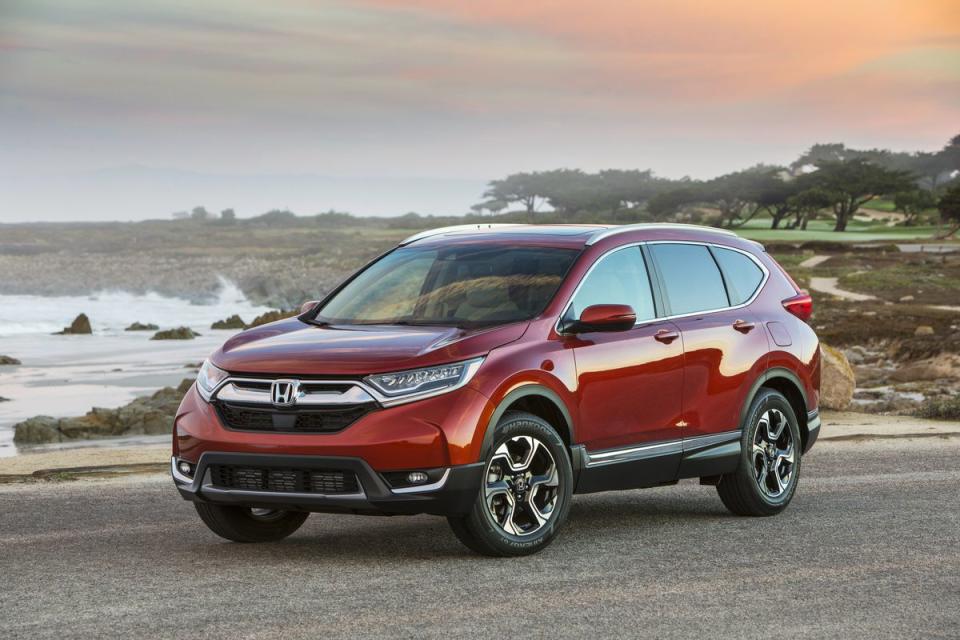2020 Ford Escape vs. Honda CR-V and Toyota RAV4: How Does the All-New Ford Measure Up?

We compare the interior and exterior dimensions of the all-new 2020 Ford Escape and its two main rivals: the Toyota RAV4 and the Honda CR-V.
We also look at cargo space, powertrains, and available features.
The new Escape will be on sale this fall.
The Ford Escape is all new for 2020 and sports a rounder, more carlike body than the model it will replace. The lower roofline gives the new Escape a more compact appearance than its key rivals, the Toyota RAV4 and the Honda CR-V, but what does that mean for interior and cargo space? Ford is also introducing a turbocharged three-cylinder engine as the base powertrain for the Escape. How will that compare with what you get inside the hot-selling compact crossovers from Honda and Toyota? Take a look at the numbers below to see how the Escape stacks up.
Engines and Towing
A choice of four powertrains will be offered on the Escape. The first is a turbocharged 1.5-liter three-cylinder that makes 180 horsepower. The CR-V and the RAV4 both offer nonturbo four-cylinders as their base engines. But, whereas the Honda's 2.4-liter four makes 184 ponies–close to even with the Ford–the Toyota's 2.5-liter makes 203 horsepower. The upgrade engine in the Escape is a 250-hp turbocharged 2.0-liter inline-four, which outdoes the Honda's upgraded 1.5-liter turbo four by 60 horsepower; Toyota offers no equivalent powertrain.

What the Toyota does offer is a hybrid model of the RAV4. It uses two electric motors to augment the 2.5-liter four's power, which is increased to 219 horsepower. The Escape will offer two hybrid powertrains, the first of which is set up similarly to the RAV4's, pairing a nonturbo four-cylinder with an electric motor for 198 horsepower; the second hybrid model will be a plug-in hybrid with 209 horsepower, front-wheel drive, and a 30-mile all-electric driving range.
The Escape can tow up to 3500 pounds when equipped with the larger turbocharged gasoline engine, and the hybrid models can each tow 1500 pounds. The RAV4 is rated at just 1500 pounds for the nonhybrid and 1750 for the hybrid model, while the CR-V comes with a 1500-pound rating no matter which engine you choose.
MPG and EPA Ratings
The EPA hasn't released fuel-economy estimates for the 2020 Ford Escape yet, but it faces tough competition from the CR-V and the RAV4. Gasoline-powered versions of the RAV4 are rated at up to 35 mpg highway, and the CR-V carries a 34-mpg highway rating with the optional 1.5-liter turbocharged engine. Both the CR-V and the RAV4 managed 32 mpg on our 200-mile highway fuel-economy test route. The Ford Escape hybrid will go up against the RAV4 hybrid, which offers an EPA rating as high as 41 mpg city; neither the Honda nor the Toyota offer a plug-in-hybrid version of their compact SUVs.
Exterior Dimensions
In a world of benchmarking, it's no surprise that these three compact SUVs offer nearly identical exterior dimensions, but the Escape is wider, taller, and rides on a longer wheelbase than the RAV4 or CR-V. It's only 0.1 inch shorter overall than the CR-V, yet the new Escape looks smaller. That visual trick is accomplished by the curvy styling that stands in stark contrast to the other two vehicles' blocky, squared-edge designs.

Interior and Cargo Capacity
Thank to its longer wheelbase, the new Escape offers more legroom in both the front and back seats than the CR-V and RAV4; front-seat legroom is 42.4 inches versus 41.3 for the CR-V and 41.0 for the RAV4. Rear seat occupants may not be able to tell the difference in legroom between the Ford and Honda though as there's only a scant 0.3-inches of extra space in the Escape. Despite the Escape's slightly-sloped roofline, its rear-seat headroom is 0.1-inches more accommodating than the CR-V and 0.2-inches roomier than the RAV4.
While the Escape offers slightly more space for people, it lacks the cargo capability of its two key rivals. The RAV4 offers more than four cubic feet of extra cargo space with its rear seats folded; the CR-V dominates both of them in this metric, with over 10 more cubic feet of cargo space than the Escape and six more than the RAV4.
Features and Safety
Ford has made its Co-Pilot360 suite of driver-assistance features standard on all 2020 Escape models. The bundle of features includes automatic high-beam headlamps, blind-spot monitoring with rear cross-traffic alert, lane-keeping assist, and automated emergency braking with pedestrian detection. Most of those features are also standard on the RAV4 (blind-spot monitoring is still optional there), but getting them on a CR-V requires upgrading to the midrange EX model. Toyota also makes adaptive cruise control standard on the RAV4; it is optional on both the Ford and the Honda.

The Escape will offer an 8.0-inch touchscreen infotainment system on SE models and up, plus 4G LTE Wi-Fi, an optional digital gauge display, and a head-up display (on the Titanium model only). RAV4 buyers can choose from either a 7.0- or 8.0-inch touchscreen infotainment system and also get Wi-Fi as standard, but they can't spec a digital gauge display or a head-up display on any model. The largest infotainment display offered on the Honda is a 7.0-inch unit, and none of the other mentioned amenities can be had at any price.
Price
Speaking of price, Ford hasn't yet announced pricing for the new Escape, but prices of the RAV4 and CR-V are similar and range from a base price around $25,000 to about $35,000 for top-spec models. To be competitive, the Escape will need to be priced in that same area; the current 2019 Escape lineup falls into this range, and we expect the new one won't deviate too far from the model that's on sale now. We'll know more closer to the 2020 Ford Escape's on-sale date this fall.
('You Might Also Like',)

